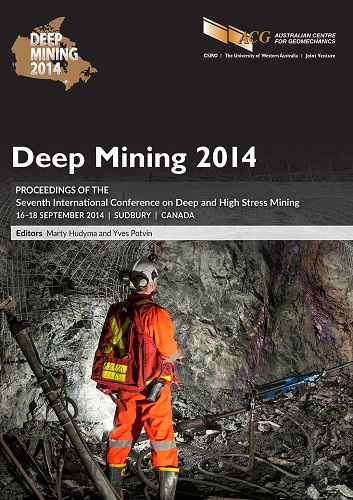Numerical modelling and scientific visualisation – integration of geomechanics into modern mine designs

|
Authors: Cotesta, L; O'Connor, CP; Brummer, RK; Punkkinen, AR |
DOI https://doi.org/10.36487/ACG_rep/1410_25_Cotesta
Cite As:
Cotesta, L, O'Connor, CP, Brummer, RK & Punkkinen, AR 2014, 'Numerical modelling and scientific visualisation – integration of geomechanics into modern mine designs', in M Hudyma & Y Potvin (eds), Deep Mining 2014: Proceedings of the Seventh International Conference on Deep and High Stress Mining, Australian Centre for Geomechanics, Perth, pp. 377-394, https://doi.org/10.36487/ACG_rep/1410_25_Cotesta
Abstract:
As mines progress to depths for which the induced stress levels exceed the intact strength of the host rock, significant challenges related to rock mass instability must be met. However, given complexity and the scale of orebodies in deep mines, it is increasingly more challenging to predict/pinpoint where and when stress levels will become problematic. Prediction of where and when large scale instabilities will occur continues to be the ‘holy grail’ of rock mechanics in deep mining. There is no perfect solution; however, there have been a number of technological advancements that greatly helped to develop our understanding of rock mass behaviour and the risks pertaining to deep hard rock mines. It is recognised that at the mine scale, geology and material properties are not fully known, however, using past experience and sound engineering judgment, it is possible to use innovative tools and methodologies to arrive at a reasonable approximation of how a rock mass will behave at depth. The main goal of this paper is to provide an overview of how some of these tools and methodologies have evolved and are actively being applied to the planning of deep mines. Vale Canada Ltd.'s Creighton Mine will be used as a case study to demonstrate how these new techniques have contributed to a better understanding, and hence a better mine planning approach for hard rock mines at depth.
References:
Andrieux, PP, Hudyma, MR, O’Connor, CP, Li, H, Cotesta, L, & Brummer, RK 2008, ‘Calibration of large-scale three-dimensional
non-linear numerical models of underground mines using microseismicity data’, Proceedings of the First International FLAC/DEM Symposium, Itasca Consulting Group, Inc., Minneapolis, on CD-ROM.
Brummer, RK 1999, ‘Simple truths about rockbursts’, Proceedings of the 2nd South African Rock Engineering Symposium: SARES99, TO Hagan (ed.), South African National Institute of Rock Engineering, pp. 6-11.
Brummer, RK, & Kaiser, PK 1995, Identification of Rock Instability: Current Practice Survey, report submitted to Atomic Energy Canada Ltd., Geomechanics Research Centre, Sudbury.
Castro, L, McCreath, D & Oliver, D 1996, ‘Rock mass damage initiation around the Sudbury Neutrino Observatory Cavern’, Proceedings of the 2nd North American Rock Mechanics Symposium, vol. 2., A.A. Balkema, Rotterdam, pp. 1589-1595.
Diederichs, MS 1999, ‘Instability of hard rock masses: the role of tensile damage and relaxation’, PhD thesis, University of Waterloo, Waterloo.
Fairhurst, C 2004, ‘Nuclear waste disposal and rock mechanics: contributions of the Underground Research Laboratory (URL), Pinawa, Manitoba, Canada’, International Journal of Rock Mechanics & Mining Sciences, vol. 41, no. 8, pp. 1221-1227.
Gibowicz, SJ & Kijko, A 1994, ‘An Introduction to Mining Seismology’, 1st edn, Academic Press, San Diego.
Henning, JG, Cotesta, L & Kaiser, PK 2003, ‘Geomechanics design of underground excavations utilizing virtual reality’, in R Singhal, K Fyta & C Chiwetelu (eds), Proceedings of the Fourth International Conference on Computer Applications in the Minerals Industries, University of Calgary, Calgary, on CD-ROM.
Hudyma, MR, Milne, D & Grant, DR 1995, Geomechanics of Sill Pillar Mining in Rockburst-Prone Conditions, Final report: Sill Pillar Monitoring Using Conventional Methods, Mining Research Directorate, Ontario.
Kaiser, PK, Henning, J, Cotesta, L & Dasys, A 2002, ‘Innovation in mine planning and design utilizing collaborative immersive virtual reality (CIVR)’, Proceedings of the 104th CIM-AGM, Canadian Institute of Mining, Metallurgy and Petroleum, Westmount.
Leslie, I & Vezina, I 2001, ‘Seismic data analysis in underground mining operations using ESG’s Hyperion Systems’, Proceedings of the 16th Quebec Mining Association Ground Control Colloquium.
Martin, CD 1994, ‘The strength of massive Lac du Bonnet granite around underground openings’, PhD thesis, University of Manitoba, Winnipeg.
Maybee, G, Sampson-Forsythe, A, Cotesta, L, & O'Connor, C 2007, ‘Geomechanical challenges at Xstrata Nickel's Thayer Lindsley Mine’, in Y Potvin, J Hadjigeorgiou & D Stacey (eds), Challenges Deep and High Stress Mining, Australian Centre for Geomechanics, Perth, pp. 233-239.
Ryder, JA 1988 ‘Excess shear stress assessment of geologically hazardous situations’, Journal of the South African Institute of Mining and Metallurgy, vol. 88, pp. 27-39.
Vorauer, A & Cotesta, L 2005, ‘Scientific visualization for enhanced interpretation and communication of heoscientific information’, Proceedings of the Canadian Nuclear Society, Waste Management, Decommissioning and Environmental Restoration for Canada’s Nuclear Activities: Current Practices and Future Needs, Canadian Nuclear Society, Toronto.
© Copyright 2025, Australian Centre for Geomechanics (ACG), The University of Western Australia. All rights reserved.
View copyright/legal information
Please direct any queries or error reports to repository-acg@uwa.edu.au
View copyright/legal information
Please direct any queries or error reports to repository-acg@uwa.edu.au